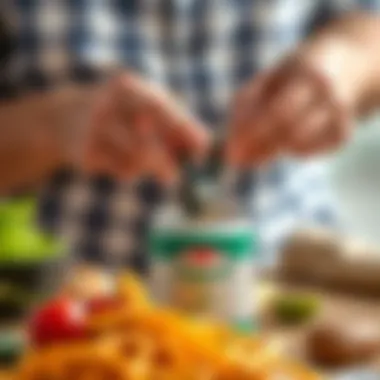Top Hand Can Openers for Seniors: Expert Insights


Intro
Navigating the kitchen can be a daunting task for seniors, especially when it comes to opening cans. Traditional can openers often require a decent amount of strength and dexterity, which may not be available as easily as they once were. Making sure that food remains accessible should not be an uphill battle; hence, the importance of choosing the right can opener is paramount.
This article delves into the realm of hand can openers tailored specifically for older adults. The focus will be on how these tools can craft a smoother culinary experience. It's about striking a balance between functionality and comfort, allowing seniors to maintain their independence in the kitchen.
Caregivers, too, will find valuable insights here for selecting tools that ease both food preparation and peace of mind.
As we dive into different aspects, like ergonomic design and safety features, we aim to provide a complete toolbox of options for everyone involved.
This guide aims to arm readers with the knowledge to make informed decisions and find can openers that resonate with their unique needs.
Understanding the Need for Specialized Can Openers
When it comes to the kitchen, the hurdles faced by seniors can often be overlooked, yet they are a significant consideration in everyday cooking. Specialized can openers are more than just a tool; they serve as a bridge to independence for older adults who cherish preparing their own meals.
The process of opening a can, something many of us take for granted, can pose a real challenge for some seniors. Cramped hand strength, diminished dexterity, and the risk of cuts or slips can turn an innocent can into a fortress that’s nearly impossible to tackle. This unfortunately can lead to frustration and even a reluctance to use certain ingredients altogether. Understanding these challenges is the first step in addressing them, ensuring that seniors maintain their culinary freedom and safety in the kitchen.
Common Challenges Faced by Seniors in the Kitchen
Seniors often grapple with various issues that complicate tasks such as using can openers:
- Reduced Grip Strength: As individuals age, they may find it harder to exert the necessary force to operate traditional can openers. This can lead to hand fatigue quickly, discouraging them from preparing fresh meals.
- Limited Dexterity: Conditions such as arthritis can cause pain and stiffness in the joints. A standard can opener may be cumbersome for those dealing with these issues, often resulting in an unpleasant experience.
- Safety Hazards: Using a can opener can lead to accidents if it slips or if the lid is sharp. Seniors may worry about injury, which can deter them from using cans altogether.
- Visual Impairment: Difficulty in seeing what they are doing can lead to improper use, resulting in spills or injury. Specialized designs can help in making the process clearer and more secure.
These challenges are not just minor inconveniences; they can lead to a decreased quality of life, especially for those who love to cook. Thus, addressing the need for specialized tools is paramount in helping seniors regain their independence in the kitchen.
Importance of Ergonomic Design
An ergonomic design is not just a buzzword; it signifies a thoughtful approach towards making kitchen tools more accessible and user-friendly. For can openers, ergonomic attributes are crucial. Here’s why they matter:
- Comfort and Efficiency: Ergonomically designed can openers often feature a comfortable grip that fits the hand naturally, reducing the strain on fingers and wrists. This is particularly beneficial for those with arthritis or general hand weaknesses.
- Ease of Operation: Many of these devices are designed so that less physical effort is required to turn the handle or push a lever, thereby minimizing fatigue.
- Improved Safety: With features like built-in safety blades that prevent sharp edges, ergonomic can openers protect seniors from cuts, thereby offering peace of mind while they cook.
- Intuitive Use: When a tool is designed with seniors in mind, it often incorporates intuitive features, meaning it can be easier to understand and use. Simplifying the operation process can lead to increased confidence in the kitchen.
As we explore various can openers, their designs reflect a commitment to supporting seniors. Investing in these specially designed can openers opens up possibilities for enjoyment and autonomy in the kitchen once again.
The right can opener is not just a tool; it’s a pathway to independence.
In the following sections, we’ll dive deeper into specific features and options that can help seniors choose the best can opener tailored to their unique challenges and preferences.
Features to Consider When Buying a Can Opener for Seniors
When it comes to selecting a can opener for seniors, various features play a crucial role in ensuring that the tool is not only effective but also user-friendly. Understanding these features can make all the difference in enhancing the cooking experience, allowing older adults to handle kitchen tasks with independence and ease. The right choice can improve safety, save time, and instill a sense of confidence in the kitchen.
Ease of Use and Mechanical Design
A can opener's design significantly impacts its ease of use, particularly for seniors who may have limited strength or dexterity in their hands. Look for can openers that are intuitive—models fitted with a simple one-hand operation are often preferred. A lever-style can opener with a comfortable grip can alleviate stress on the hands. As an added bonus, some options feature soft-touch grips that can reduce slippage and are designed to minimize the effort required to operate.
The mechanical design should allow for smooth operation without requiring excessive twisting or turning. Devices that open cans without needing to puncture the lid first, such as smooth-edge models, can be especially beneficial, as they remove the sharp edges often left behind. Having a can opener that operates with minimal physical exertion can make a world of difference.


Safety Features to Prevent Injuries
Safety is paramount when selecting a can opener for seniors. Many traditional can openers present a real hazard with sharp edges and potential for pinched fingers. Thus, investing in a model adorned with safety features is important. Look for openers that provide a clean cut, leaving no hazardous edges. Some electric options are designed to automatically shut off once the can is opened, preventing unnecessary accidents.
Furthermore, if a manual can opener has a locking mechanism, that’s a feature to appreciate. It keeps the device securely in place while in use, reducing the likelihood of slippage. Having non-toxic materials and BPA-free plastics is also a considerable aspect to look for, as these materials position safety advantageously in the kitchen environment.
Durability and Maintenance Requirements
Durability is something that can’t be compromised on. Seniors deserve products that can withstand frequent use, saving them from frequent replacements. Stainless steel can openers are generally sturdy and resistant to rust, which translates to longer-lasting utility. It’s beneficial to check whether the gears and handle are well-constructed since these fixtures endure the most wear and tear.
Maintenance should also be uncomplicated. Models that can be easily disassembled for cleaning are highly recommended, particularly those that are dishwasher safe. This practical aspect not only encourages good hygiene but also means that seniors can keep their tools in great condition with minimal effort.
In summary, keeping ease of use, safety, and durability in mind when selecting a can opener for seniors empowers them to handle their kitchen tasks effectively. The ideal can opener meets their specific needs while providing an efficient and enjoyable cooking experience.
"Selecting the right tools makes all the difference for those who spend time in the kitchen—especially for seniors."
For more informative resources regarding kitchen tools suitable for seniors, visit Britannica.
Top Hand Can Openers for Seniors Reviewed
Choosing the right can opener can make a world of difference for seniors. Not only does it simplify their tasks, but it also enhances their overall kitchen experience. The market is replete with various can openers, and recognizing which models best cater to the unique needs of older adults is pivotal. Here, we dissect both electric and manual can openers, weighing their advantages and determining which models shine in functionality, ease of use, and safety features.
Electric Can Openers: Pros and Cons
Electric can openers offer a certain level of convenience that can be enticing for seniors, especially for those with limited hand strength or dexterity. These gadgets operate with a simple push of a button. However, they are not without their shortcomings.
- Pros:
- Cons:
- Effortless Operation: Just place the can, press a button, and let the opener do the work. This means even those with arthritis or other grip issues can open cans with little to no effort.
- Safety Features: Many models come equipped with mechanisms that keep sharp edges contained, reducing the risk of cuts.
- Dependency on Power: A power outage or the device running out of batteries can leave one stuck, particularly if they had banked on a quick meal.
- Potential for Malfunctions: Like any gadget that relies on electrical components, there’s the chance it may fail, leading to frustration.
Manual Can Openers: Best Models
Manual can openers come in many forms. They can be traditional lever models or innovative designs aimed at enhancing the user experience. Here, we look at three categories of manual openers to evaluate their functionality.
Classic Designs
Classic manual can openers carry a nostalgic touch, and they remain popular due to their simplicity and effectiveness.


- Key Characteristic: Their basic design includes a metal wheel that punctures the can lid. It’s a tried-and-true method that's served many for decades.
- Benefits: These openers tend to be lightweight and portable. Due to fewer moving parts, they often require minimal maintenance, making them convenient for everyday use.
- Unique Feature: One major advantage is their affordability. With a lower price tag, they are accessible to all seniors, allowing many to find one that suits their style without breaking the bank. However, they may require a bit of hand strength, particularly if the lid is on tight.
Ergonomic Picks
Ergonomically designed openers provide a thoughtful solution tailored to the specific needs of older adults, emphasizing comfort and usability.
- Key Characteristic: These models often feature cushioned grips and unique shapes that promote a natural hand position, reducing strain.
- Benefits: Many seniors prefer these due to the ease with which they can be manipulated. Less force is required, enabling a smoother experience.
- Unique Feature: Some ergonomic can openers are designed to work well with different can types, accommodating various lid styles without much fuss. Nevertheless, they can sometimes come with a steep price tag, which may deter some users.
Budget Options
The market has budget-friendly manual can openers that deliver functionality without costing an arm and a leg.
- Key Characteristic: These tools are generally straightforward with fewer bells and whistles, focusing mostly on their primary task—opening cans.
- Benefits: They can provide immense value for seniors who want a reliable tool without investing in higher-end models.
- Unique Feature: Despite their low cost, some budget options are surprisingly durable and can last through the repeated wear and tear of daily kitchen use. The downside is that they may lack some of the modern safety features found in pricier models.
In summary, the best can opener for seniors ultimately depends on individual preferences and needs. Whether they opt for an electric model or a tried-and-true manual version, the right can opener can make cooking a stress-free experience.
How to Properly Use a Can Opener
Understanding how to properly use a can opener is critical, especially for seniors who may encounter unique challenges in the kitchen. A can opener isn’t just a tool; it’s a gatekeeper to convenience and independence. For many people, being able to easily open a can means being able to prepare meals without additional help, fostering a sense of autonomy. The importance of mastering this skill cannot be understated, as it affects both the enjoyment of cooking and the ability to maintain a healthy diet.
In this section, we’ll dissect the process of using manual can openers, focusing on specific elements that contribute to an effective and safe can-opening experience. Additionally, we will delve into best practices that can enhance the overall experience, ensuring that seniors feel confident and secure while using these tools.
Step-by-Step Guide to Using Manual Can Openers
Using a manual can opener might seem straightforward, but following a few steps can make the task much easier and safer:
- Prepping the Can: Start by ensuring the can you plan to open is stable. Placing it on a flat surface will help immensely. This prevents unnecessary shaking or tilting while you work.
- Positioning the Opener: Align the blade of the can opener with the edge of the can’s lid. Make sure the blade is right on the rim; this position is key to ensure a clean cut. If your opener has handles, grasp them firmly.
- Clamping Down: Squeeze the handles together to puncture the lid. You ought to hear a slight click. This indicates that the blade has engaged properly with the lid. Keep the handles squeezed but be careful not to apply too much pressure, as it can make it difficult to turn.
- Turning the Handle: Begin to rotate the handle of the can opener. Do it steadily. The blade should cut into the lid as it goes around. If you feel resistance, it’s possible that the can isn’t positioned correctly, so take a moment to adjust.
- Completing the Cut: Once you’ve made a full rotation and the lid is punctured all the way around, gently lift the blade out. If the lid remains attached, a slight push should free it up. Be cautious of sharp edges during this step.
- Disposal: Dispose of the lid immediately after use, and make sure to clean any remaining debris up. This will help maintain hygiene in your cooking space.
This whole process doesn’t take much time, but it surely requires a modicum of care to avoid mishaps.
Tips for Safe Operation
Safety is paramount when using can openers, especially for seniors. Here are some essential pointers to consider:
- Choose the Right Tool: Ensure that the can opener is the right fit for your hand. A handle that is too small or difficult to grip can lead to accidents.
- Inspect the Can: Before opening, check that the can is free of denting or rust which can compromise safety and hygiene.
- Use Firm Yet Gentle Force: Applying too much force can lead to slips and falls. Maintain a steady, gentle grip instead.
- Cut Away From Your Body: Always operate the opener away from your body. This habit will help mitigate the risk of injury should something go awry.
- Wear Protective Gloves: If you have concerns about sharp edges or slips, donning a pair of cut-resistant gloves may add a layer of safety.
"Safety isn’t just a priority; it should be a way of life. In the kitchen, this couldn’t be truer."
By following these steps and tips, seniors can enjoy a more confident and safer can-opening experience. Taking the time to learn how to correctly use a can opener can open up a world of culinary possibilities, while simultaneously ensuring that the process remains enjoyable.


Maintenance and Care for Can Openers
Maintaining your can opener is just as important as choosing the right one. Keeping it clean and well-cared for ensures not only its longevity, but also the safety of the food you'll be preparing. An overlooked can opener can harbor bacteria and result in unexpected repairs or replacements, which is not something anyone looks forward to. So let’s break down the essentials of maintaining these kitchen tools, especially tailored for seniors who might benefit from an easier experience.
Cleaning and Hygiene Practices
Keeping your can opener clean is essential for safe food handling. Over time, bits of food and moisture can accumulate in hard-to-reach areas, creating a breeding ground for bacteria. Here are a few straightforward steps to ensure clean operation:
- Disassemble When Possible: If your can opener can be taken apart, remove all detachable parts after each use. This not only allows for a deeper clean but also helps you spot any damage.
- Wash Thoroughly: Use warm, soapy water to scrub all components. For manual can openers, focus on the cutting wheel where food tends to stick. A soft-bristle brush could be handy here. Whether it’s a handheld version or electric, don’t forget to rinse everything off completely.
- Dry Carefully: After washing, ensure that every part is dried properly to prevent rust. Any leftover moisture can be a fast track to tarnishing your tool’s longevity.
- Occasional Sanitation: Every now and then, consider dipping the parts in a vinegar solution or a diluted bleach solution to effectively kill off any lingering germs. Rinse and dry thoroughly after this treatment.
Regular cleaning not only extends the lifespan of your can opener but also promotes good kitchen hygiene, an aspect essential for keeping your food safe.
Storage Solutions to Enhance Longevity
Where you store your can opener matters just as much as how you clean it. Proper storage can prevent damage, wear, and even accidental injury. Here are some storage solutions:
- Designated Drawer or Container: Consider having a specific place where your can opener resides. Use a drawer organizer to keep it separated from other utensils. This minimizes the risk of bumping into sharper edges that might cause cuts.
- Hang It Up: For some, hanging the can opener on a hook can be a practical solution. This way, it’s out of the way but easy to grab whenever needed. Just ensure the hook is secure and not in a location that might catch on clothing or skin.
- Avoid Stacking in Drawers: Stacking kitchen tools can lead to scratches and gnarly rust spots. Try to store the can opener in a way that it isn’t stacked with heavier items.
- Silica Gel Packs: If you tend to have moist conditions in your kitchen, consider tossing in some silica gel packs where you store your can opener. They absorb humidity and can help stave off corrosion.
Taking care of your can opener is a small but essential part of kitchen maintenance. By keeping it clean and stored correctly, you are not only ensuring a tool that works well but also a safer cooking environment.
The End: Finding the Right Can Opener
Choosing the right can opener is not merely a matter of convenience, especially for seniors. It’s about safety, independence, and fostering an enjoyable cooking experience. With age, some may face physical challenges that can turn even simple tasks like opening a can into a daunting chore. Hence, understanding individual needs when selecting the appropriate can opener becomes crucial.
One should first consider unique challenges faced by older adults. For instance, some might struggle with grip strength or dexterity. Thus, a can opener with an ergonomic handle can make a world of difference. Grabbing the right tool can help restore a sense of control in the kitchen, allowing seniors to independently prepare their meals without frustration. This is especially important, as cooking plays a fundamental role in well-being.
When evaluating options, prioritize features such as ease of use, safety mechanisms, and durability. A can opener that ensures smooth operation even in the hands of someone with limited strength can significantly enhance their kitchen experience. Moreover, purchasing a product that offers safety features can reduce the risk of cuts and accidental injuries.
"Picking a can opener tailored to your needs might feel like a small detail, but it can improve daily life in big ways."
Evaluating Options Based on Individual Needs
In considering the various models available on the market, one must take an individual approach. Seniors may have diverse requirements based on their physical abilities or health concerns. For example, those who have arthritis could benefit from a lightweight model with a rotation lever that requires minimal effort.
- Grip strength: Look for openers with soft grips or larger handles designed for comfort.
- Finger dexterity: A model that doesn't require complex hand movements can aid those with limited dexterity.
- Visual impairments: Openers with clear markings or bright colors can assist in easy recognition.
- Weight and size: Lighter models may be more manageable for seniors who prefer to keep their kitchen tools easy to handle.
All these factors come into play for a thoughtful selection process.
Final Recommendations for Purchase
After assessing individual needs and options, making a final decision can still be tricky. It’s essential to do a bit of homework on the reliability of the product. Look for brands known for their quality and customer feedback.
Here are some key points to think about before buying a can opener:
- Read reviews: Check both product reviews and user experiences on platforms like Reddit and Amazon.
- Try before buying: If possible, physically handle a few models to see which ones feel comfortable.
- Warranty and return policies: Choose products that come with a satisfaction guarantee or warranty, as this can save you from buyer's remorse.
- Consider brand reputation: Reliable brands such as OXO or Kuhn Rikon often lead the pack when it comes to ergonomic tools designed for ease.
In summary, the right can opener can greatly influence the cooking experience for seniors. By closely evaluating individual needs, identifying features, and selecting wisely, one can ensure that mealtime remains a joyful and untroubled task.







